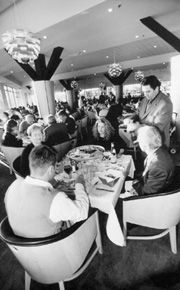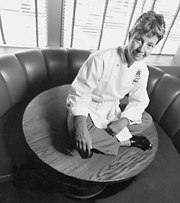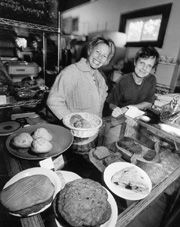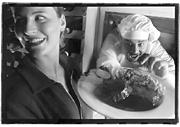WHEN I WAS A KID growing up in this city, the places to go for fancy nights out were waterfront restaurants like the Windjammer at Shilshole and the Polynesian on Elliott Bay. Big and formal, all white linen and crumb scoop-clutching mae d’s, these places featured plenty of seafood on their menus and miles and miles of broad, watery views out the windows.
Waterfront Pier 70, 2801 Alaskan, 956-9171 lunch Tue-Sat 11:30am-2:30pm; dinner Mon-Thu 5-10pm, Fri-Sat 5-11pm, Sun 4-10pm AE, DC, MC, V; full bar
Funny, I don’t remember the food.
Fast-forward to Seattle 2000 and once again the place to go for a fancy night out, as Paul Mackay would have it, is the waterfront. More specifically, the Waterfront. For months the local dailies and glossies have been gaga over the creation of this vast, creamy wonderland out of the stub end of Pier 70, masterminded by a veteran restaurateur whose career began, fittingly, at the Windjammer in the ’60s.
After that Mackay’s r鳵m頲eads like a biography of Seattle’s restaurant scene: from the original El Gaucho and 13 Coins to the Metropolitan Grill and Yarrow Bay Grill to Flying Fish and, ultimately, the new El Gaucho. Mackay’s undeniably a classic; he’s been going long enough to reprise himself. Now, with Waterfront, he seems to be angling for immortality.
The place is take-your-breath-away stunning. Sure, there are the sleek blond appointments, the sunny golden backdrops, the requisite white linens—but these design elements pale before the elemental joy of being altogether surrounded by water and sky. Waterfront slices like a blade down the shank of the pier, and Mackay had the good sense to sheath it entirely in windows, then preserve sight lines throughout the room. As a result you could pitch a seared prawn from end to end in the place, if your arm were good enough. Of course you might hit a sleek blond appointment. (You’d almost certainly hit a sleek blond.)
Twice we assumed our places among the beautiful people to sample Waterfront’s food, the province of Mackay’s partner, chef Vicky McCaffree. Her passion as head chef at Yarrow Bay was seafood; hence fish takes center stage at Waterfront. You can begin with such purities as a dozen tiny Kumamotos on the half-shell ($9.50), thoughtfully served with a refreshing cup of margarita sorbet; a noble strip of tuna carpaccio ($12) served with shaved fennel and orange salad; or a generous hunk of Kasu black cod ($12), appropriately rich as Croesus, served with marinated ginger and sushi rolls (whose rice was unfortunately more grainy than sticky).
Thai crab cakes ($14) were unimpeachably tasty, swabbed around in creamy drops of basil avocado aioli. So was softshell crab tempura ($13), which elegantly crossed flavors with bitter arugula and big dollops of wasabi cream. The pizza appetizer of the day ($8.50) was a smoky construction of crimini and mousserone mushrooms, tomatoes, goat cheese, and greens over a crackly base—a solid hit mainly for the marriage of the woodsy mushrooms with a uniquely sweet tomato sauce.
Waterfront’s calamari ($8.50) also departed from the norm in the manner of its preparation. Seared, not breaded and fried, the squid came dressed in ginger, lime, garlic, and sesame oil—perhaps too heavily dressed. McCaffree and her crew are clearly not afraid of strong flavors, the result being calamari so swathed in citrus it tasted like it had been plucked from a tree.
Likewise, the two salads we sampled featured boldness of different sorts. The Roquefort salad ($8) was overdressed and punctuated with walnuts and sweet beets; the warm spinach salad was dandily pocked with whole toasted hazelnuts, but topped with a plump, breaded beret of goat cheese that managed to flog the rest into withering submission.
NOW I HAVE NOTHING against strong flavors. Strong flavors can be triumphant when coaxed gently from the food and framed with care. However, at Waterfront strong sauces sometimes tend to assault their partners. Interestingly, this occurred mostly with fish: The meat we tried tasted balanced. Rack of lamb ($38), aesthetically presented as a sort of visual haiku on the plate, stood up beautifully to its strong Burgundy demi-glaze. Grilled New York steak ($35), a nod to El Gaucho, was a charry wonder, richly presented with mashed potatoes in a smoky bordelaise sauce.
Pepper-seared ahi ($26.50), which was slightly tougher than I want the undercooked fish to be, appeared in a green peppercorn sauce that was saltier than the fish warranted. Poached Alaskan halibut ($23) was cooked perfectly and complemented by a citrus sauce that was divine on the first few bites, but tiresomely cloying by the end. One evening’s special, striped bass encrusted with purple potatoes and served over mashed potatoes in a passionfruit beurre blanc streaked with cilantro oil ($28.50), was an unreasonably brash thing to do to a fine piece of fish, the sauce being far too vinegary.
Fried “Magnificent Flavor” fish ($26) is an ancient Chinese method of frying fish—in this case, sea bass—whole, head and all, then serving it with a dipping sauce. Though the ginger-scallion sauce was sweet and unsubtle, it worked with the oily fish. Alas, the accompanying rice and Chinese broccoli were altogether dessicated. Thai seafood stew ($28.50) submerged crab, prawns, scallops, and mussels in a fine lemongrass coconut broth.
The dessert menu read “boring”; thankfully they tasted a little better. The mocha pot de cr譥 ($7.50) was unmemorable yet fine, as was a banana split ($7.50) made with housemade ice creams and warm rum caramel sauce. Best was the warm bittersweet chocolate chai tea souffl頣ake ($7.50), which was interestingly light and fragrant with cardamom. (I still think the list could use a good solid fancied-up classic or two; a cheesecake maybe, or some splurgy outlandish chocolate thing. Just a thought.) None, however, were must-haves.
Which pretty much forms my assessment of the whole place. Correction: The place is first-rate; it’s just the food that leaves one lukewarm. Factor in service and I’m afraid you’re altogether stranded in the ’60s. On both visits we were almost entirely in the hands of unctuous mae d’s, fawning wine stewards, and Stepford waiters, who seem to believe that good service proceeds directly from phony smiles and poker-faced formality. One waiter was so uninformed about the food he couldn’t elucidate the difference between a softshell and a Dungeness crab; this, in a Seattle restaurant, ought to be grounds for dismissal.
That they rushed us through our second dinner was the final indignity; the sure sign of a restaurant whose identity is anchored more in its bottom line than its hospitality. This may well be the key to Paul Mackay’s decades-long record of success. But it won’t bring me back—view or no view.








